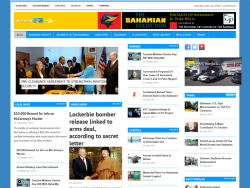Minister of Economic Development Zhivargo Laing, Dr. Peter Maynard, President of the Bar Association Mr. Mark Smith, Director of the Grand Bahama Chamber of Commerce, Fellow Speakers, Ladies and Gentlemen Good Morning.
On September 11, the United States, and indeed this entire region of the world, endured a grievous blow. However, working together we will overcome this enormous tragedy. I would like to take this opportunity to thank our good neighbors in The Bahamas for your outpouring of condolence and support.
The events of September 11 and the resulting economic dislocations, which are so evident here in The Bahamas, have once again demonstrated the importance of a well-functioning economic system to the welfare of ordinary citizens. It is appropriate, therefore, to return for a moment to basics and emphasize that the economic welfare of their citizens is the reason why the United States and The Bahamas are considering the FTAA. It would, after all, be possible for both The Bahamas and the United States to engage in no trade with the outside world. However, as Adam Smith and David Ricardo taught us, the economic welfare of our citizens can be increased if we trade with each other.
I have followed trade policy with great interest over the course of my 16 years with the State Department and have dedicated 3 full years of my career to trade matters. From 1997 to 1998, I served as the Director for the Middle East and the Mediterranean at the Office of the U.S. Trade Representative, and spent the following two years in Paris as the Trade Advisor at the U.S. Mission to the OECD.
What I would like to do today is to explain the U.S. position on the FTAA, outline the progress that has been made so far in the negotiations, and finally offer a few of my own thoughts on the opportunities and challenges the FTAA poses for The Bahamas.
But before I begin, let me congratulate the Grand Bahama Chamber of Commerce for hosting this event and Minister Laing for coming to Freeport to participate in this seminar. There was a time when trade agreements could be negotiated by faceless bureaucrats like myself with little, if any, public attention. But those days are past. One thing we learned from the WTO Ministerial in Seattle was the importance of consulting all elements of what is called “civil society” throughout the negotiating process. Seattle taught us that we need to encourage private sector participation and maintain a high-level of transparency. And this seminar provides one opportunity for the consultation that is so necessary to make sure that any eventual agreement has public support.
The U.S. Position on the FTAA
The United States has made negotiation of the FTAA the centerpiece of hemispheric trade policy because we believe that trade liberalization will increase the economic welfare of countries in the region and help maintain open democratic political systems.
This has been our experience with the North American Free Trade Area (NAFTA), our free trade agreement with Mexico and Canada.
When the U.S. Congress approved NAFTA in 1993, trade between the U.S. and Mexico totaled $81 billion. Last year, our trade hit $247 billion.
Since NAFTA took effect, employment has risen in all three countries.
In the first five years, employment grew 22 percent in Mexico, generating 2.2 million jobs. It grew 10 percent in Canada, or 1.3 million jobs. Finally, employment grew more than 7 percent in the U.S., or about 13 million jobs.
The average family in the U.S. has also benefited from the lower tariffs on imports negotiated in NAFTA and in the World Trade Organization (WTO). By cutting tariffs on imports such as clothing, food, housing components, cars, and so on, our Council of Economic Advisors calculates that the last round of WTO negotiations, known as the Uruguay Round, saved the average family about $310 a year. The NAFTA saved another $210.
These kinds of benefits are not confined to the United States or to developed countries.
The World Bank recently did an analysis of the performance of three types of countries: developed countries, globalizing developing countries, and those that are closed.
In the 1990’s, the income per person for globalizing developing countries grew a little over 5 percent a year. For closed or non-globalizing countries it fell a little over 1 percent a year. For developed countries, it grew about 1.9 percent a year.
The extra growth for the globalizing developing countries translated into proportionate increases in income for the poor.
FTAA Progress Report
We have made good progress so far in the FTAA negotiations.
In November 1999, Trade Ministers met in Toronto and accepted draft outlines of key issues prepared by the nine negotiating groups, committees and consultative group. The Ministers then instructed the negotiators to begin the second phase of negotiations–drafting a unified text. That work was completed in December 2000. I should stress that the draft text, which is posted on the FTAA Web Page, is just that – a draft and will be subject to a lot of improvements.
In their meeting in April of this year, trade ministers established a fixed deadline, no later than April 1, 2002, for preparing the important technical guidelines under which the detailed work of negotiating actual market access–in goods, services, government procurement, and investment–will proceed.
Product- and sector-specific market access negotiations will begin no later than May 15, 2002.
Building from these interim deadlines, the Hemisphere’s leaders, meeting at the Quebec Summit, directed that all elements of the FTAA negotiations should be concluded no later than January 2005, and that the Agreement should enter into force no later than December 2005.
The Negotiating Groups will also intensify efforts to reduce differences in their texts so that a “second draft” Agreement text can be reviewed at the next trade ministerial, which will be held no later than October 2002.
The FTAA and The Bahamas
In my view, the challenges and opportunities that the FTAA brings to The Bahamas are different from those faced by most other countries because The Bahamas is different from most countries in a couple of important respects.
First, the Bahamian economy is predominantly service-based and has a very small manufacturing sector. Tourism and financial services account for 75% of GDP, while manufacturing accounts for just 3%. As a result, elimination of import tariffs on goods will have a relatively small effect on the service-dominated economy.
It would, however, have a major effect on government revenues – the government would have to institute a different kind of tax, such as a Value Added or Sales Tax, to replace the tax on imports – but the fact I would like to stress here is that The Bahamas, unlike some other countries in the region, does not have a large manufacturing sector protected from foreign competition by high tariffs. For the most part, The Bahamas has high tariffs to raise revenue, not to protect local industry. For that reason, it will be easier for The Bahamas to become part of a free trade area than it will be for other countries in the region.
Second, the major pillars of the Bahamian economy – tourism and financial services – already are fully globalized and exposed to foreign competition. Those industries compete successfully every day for clients and have no need for the kind of trade barriers that the FTAA is designed to eliminate. For these industries, which form the backbone of the Bahamian economy, the FTAA presents an opportunity, rather than a challenge.
It creates an opportunity to attract even greater foreign investment. Even though the Bahamas services regime already is fairly open, binding it in a trade agreement would help create investor stability and confidence, which would lead to greater levels of foreign investment. Foreign investors would know that, because The Bahamas had made certain commitments in an international treaty, policies on those matters would not change from government to government. Greater foreign investment would further develop the infrastructure needed to function as a top-notch center of tourism.
Also, a good services package would provide stable export markets in the region for Bahamian service providers. Over the coming years, the growth of electronic commerce could provide exciting new opportunities for Bahamian firms. Tourism-related services, such as travel agencies, hotel reservations, air reservations, all could be provided over the Internet.
And I would point out that The Bahamas is especially well positioned to ensure a favorable services agreement because the Chairman of the FTAA Negotiating Group on Services is none other than James Smith, your Ambassador for Trade and former Governor of the Central Bank.
Conclusion
In closing, I’d like to repeat what President Bush said in his speech in Quebec: “We have a great vision before us: a fully democratic hemisphere, bound together by good will and trade. That is a tall order. It is also the chance of a lifetime. And it is the responsibility we share.”



